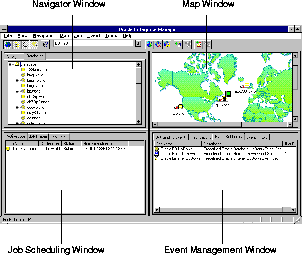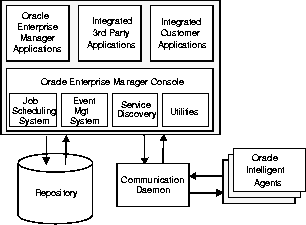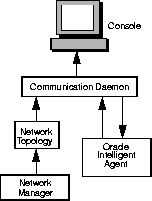Release 8.0.3
A54894-01
Library |
Product |
Contents |
Index |
| Oracle8(TM)
Getting Started for Windows NT Release 8.0.3 A54894-01 |
|
This chapter provides an overview of Oracle Enterprise Manager, Oracle Corporation's suite of products for managing Oracle8 databases over a distributed network.
Specific topics discussed are:
Oracle Enterprise Manager enables database administrators (DBAs) to manage databases distributed across a network from a single centralized Console. Database management is performed through an easy-to-use graphical user interface (GUI). From the Console, you can:
This section describes the following components that enable Oracle Enterprise Manager to manage your distributed database network.
The Oracle Enterprise Manager Console provides a central point of control through a GUI that provides drag and drop systems management. The Oracle Enterprise Manager Console consists of:
The menus, toolbars, and tools palette are context-sensitive. Integrated applications can also be launched from the Console. The menu options that display depend on which Console window is active. The tools available in the palette depend upon the type of service selected in the navigator or map windows. Press F1 to determine the context-sensitive options.
The figure below shows the four Console windows.

See the Oracle Enterprise Manager Administrator's Guide and Chapter 10, "Administering a Database" for information on using the Console menus, toolbars, tools palette, and windows. Brief descriptions of the four windows are provided in the table below.
| Element | Description |
|---|---|
|
Navigator Window |
The Navigator Window provides a hierarchical tree view of the network's nodes and services, and any objects they may contain. This enables easy object manipulation of all objects in the system. Objects include nodes, databases, listeners, users, roles, and profiles. A node contains databases and listeners. A database contains users, roles, and profiles. Each type of object in the Navigator tree list is identified by an icon and a name. An object in the tree can also be copied by dragging and dropping it. For example, you can drag and drop users from one database to another. Depending on the applications installed, additional objects such as video servers can appear. |
|
Map Window |
The Map Window provides a customized, graphical representation of key objects (such as databases) created by an administrator to manage and monitor a subset or group of objects in the system. Objects can be grouped together based on any criteria, simplifying all operations performed on the group members. The map is useful for environments with many databases and for visually representing problems detected by the Event Management System. |
|
Job Scheduling Window |
The Job Scheduling Window enables you to automate repetitive tasks and provide the kind of "lights out" management vital in a large, distributed environment. You can schedule or cancel a job and view its status, or review historical information about jobs. You can also create and manage job scripts. See the section "Job Scheduling System" and Chapter 10, "Administering a Database" for additional information. |
|
Event Management Window |
The Event Management Window enables you to create and register event sets, modify or cancel registrations, view the status of services being monitored, view summary information about events that have occurred, and further manage event information. You can choose to have the events of interest represented graphically on the Console when they are detected. The system can also notify you through e-mail or paging. See the section "Event Management System" and Chapter 10, "Administering a Database" for additional information. |
Oracle Enterprise Manager has the following set of common services that help you manage Oracle8 databases throughout the network:
The figure below shows how these common services work together to perform distributed database management across a network. Each common service is then described.

The Oracle Enterprise Manager uses the Oracle Intelligent Agent and communication daemon to manage Console tasks such as scheduling and running remote jobs, and monitoring events on remote sites. The Oracle Enterprise Manager is installed on a Windows NT or Windows 95 Console workstation. The Oracle Intelligent Agent is installed on each node with an Oracle8 Server for Windows NT database to be managed.
The communication daemon runs on the Console and communicates with the Oracle Intelligent Agent to manage jobs and events.
The Oracle Intelligent Agent is effective, nonintrusive, and functions as the executor of jobs and events sent by the Console through the communication daemon. High availability is ensured since the Oracle Intelligent Agent can function regardless of the status of the Console or network connections. The Oracle Intelligent Agent is responsible for managing and completing tasks requested from the Console workstation by the Oracle Enterprise Manager. Once installed, the Oracle Intelligent Agent:
The communication daemon uses the dynamic discovery feature to identify nodes and services on the network. The figure below illustrates this process:

The Job Scheduling System enables you to schedule and manage job tasks on remote sites. The Job Scheduling System, communication daemon, and Oracle Intelligent Agents work together to schedule and execute the job. Use the Job Scheduling System to perform asynchronous tasks on multiple sites without having to maintain connections to all those sites. In addition, jobs can run simultaneously on different nodes in the system. See the Oracle Enterprise Manager Administrator's Guide for information on scheduling and managing jobs.
The process for scheduling a job is:
The Job Scheduling System, communication daemon, and agents work in unison to schedule and execute the job. You can use the Job Scheduling System to perform asynchronous tasks on multiple sites without having to maintain connections to all those sites. In addition, jobs can run simultaneously on different nodes in the system.
The benefits of the Job Scheduling System are described in this table:
The Event Management System enables you to monitor specific events at remote sites throughout the network, such as problems on a node or database. The process to register an event set is:
When an event occurs, you can be notified in various ways, such as electronic mail or paging. Also, events are always logged in the repository and can be viewed in the Console.
The benefits of the Event Management System are described in the table below:
| Task | Description |
|---|---|
|
Proactive Events Management |
You can automate problem detection and correction in response to an event. This ensures that a problem is corrected before it noticeably impacts end-users. You can also specify a fixit job to be run in response to a particular event. For example, you can have the Event Management System monitor the tablespace TEMP in the database HR_DB and generate an alert if TEMP runs out of free space. You can also have a datafile automatically added to TEMP if this event occurs. |
|
Unsolicited Error Detection |
You can detect events with tools and applications independent of the Oracle Intelligent Agents. These tools and applications can be integrated into the Event Management System and communicate directly with the Oracle Intelligent Agents. For example, a third-party application can detect an event on a node and report that event to the Oracle Intelligent Agent on that node. The Oracle Intelligent Agent then sends the message back to the Console. |
|
Scalability |
The Event Management System allows one person to monitor a large system. If you are responsible for 100 databases, you cannot connect to each database every day to check on performance. Using the Event Management System, you can effectively monitor all databases 24 hours a day, and be alerted if a problem is detected. The Event Management System also enables you to focus on select systems and events. This control is vital in a large system. Rather than monitor all sites or a large number of sites, you can pinpoint only those services you want to monitor. An administrator can monitor a large number of sites with minimal performance impact on the Console. Because the Oracle Intelligent Agents perform the monitoring independent of the Console, an administrator can monitor many sites without slowing other tasks. |
|
Predefined Event Sets |
Standard pre-defined event sets are provided. Advanced event sets are included with the optional Performance Pack. The standard pre-defined events are the fault management events: Pre-defined event sets included with the Performance Pack are:
See the Oracle Enterprise Manager Performance Monitoring User's Guide and Chapter 11, "Monitoring a Database". |
|
Event Scripts |
As with jobs, events are OraTcl scripts that are stored on the Oracle Intelligent Agent node. Event scripts can save state information. Saving a state between executions of an event script enables the Oracle Intelligent Agent to remember if it has already detected a certain event and eliminate redundant event messages to the Console. This also enables event scripts to maintain a history of a database and adjust to behavior that is typical. Note: Unlike job scripts, event scripts are run with the permissions of the Oracle Intelligent Agent. |
|
Optimized Intelligent Agents |
The optimized intelligent agent has been optimized to monitor large numbers of systems and events efficiently. Event tests are generally executed by the agent process directly and can be run quickly. |
The Oracle Enterprise Manager repository is a database accessible from the Console. The repository:
You can have more than one repository in your system. A user is associated with one repository.
The repository provides a centralized location for storing information about the state of the environment managed by Oracle Enterprise Manager from the perspective of each Console user. It contains information on:
See the Oracle Enterprise Manager Administrator's Guide for information on creating your own repository.
Access to Oracle Services on the network is controlled by a set of user-defined, preferred credentials for the available nodes and services. Oracle Enterprise Manager caches the user authentication information in encrypted form in the repository and provides it as part of the connection request from the Oracle Enterprise Manager Console or Console-launched applications.
To access services, you must log in to the Console by using an authorized user name and password. Oracle Enterprise Manager manages the connections made on your behalf and ensures that others cannot perform operations they are not privileged to perform.
Oracle Enterprise Manager has an open architecture that enables software to be integrated with the Console. The design of these integrated applications:
Oracle Enterprise Manager includes a standard set of integrated database administration (DBA) applications that automate and simplify DBA tasks. These applications can be launched directly from the Console or the Administration Toolbar. In addition, third-parties can write applications that integrate into the Console, use the available common services, and launch from the Console. The applications available are described in the table below:
See the Oracle Enterprise Manager Administrator's Guide for information on using these tools.
The integrated database administrator applications share some common features:
Other systems management applications are available for Oracle Enterprise Manager. These applications are available from Oracle Corporation and third-party software developers.
Examples of the integration of other Oracle applications into Enterprise Manager are:
Oracle Media Server, a component of the Oracle Media suite of products, provides high-performance, scalable, and reliable multimedia library services on a wide variety of general-purpose computer platforms. Oracle Media Server provides the full range of services needed to deliver sophisticated, interactive multimedia applications to tens of thousands of simultaneous clients. Services provided can range from storage, retrieval, and management of movies, music, photographs, and text articles, to the critical customer tracking and billing applications required to deliver these commercial services, in real time, over the network.
Oracle Media Server provides a complete set of services for the delivery of multimedia applications, such as video-on-demand, home shopping, video teleconferencing, interactive learning, and personalized newspapers.
Most modules of Oracle Media Server, from the sophisticated content management, customer tracking, and customer billing services, to the highly scalable multimedia stream server, are portable to virtually any hardware or operating system environment. This enables customers to develop a system on hardware from one vendor, and later move it to a completely different system without any application reprogramming. This important capability allows you to swap in the most cost-effective and high-performance components at any point in time to save money, increase capability, and prevent vendor "lock-in". Portability at all levels (including back-end video servers, application servers, networks, set-top boxes, and their associated operating systems) means that compatibility is never an issue and your investment is never lost.
All Oracle modules are based on standards, where they exist, from the relevant interactive television standards organizations such as ANSI, ISO, MPEG, and DAVIC, all of which Oracle actively participates in, among others.
With the Oracle Parallel Server, separate Oracle instances run simultaneously on one or more nodes using a technology called parallel cache management.
A parallel server has the following characteristics:
In some configurations, each instance has its own redo log file, whereas in other configurations, there is only a single redo file.
Applications that access the database can run on the same nodes as instances of a parallel server or on separate nodes, using the client-server architecture. A parallel server can be part of a distributed database system. Distributed transactions access the data in a remote database in the same manner, regardless of whether the data files are owned by an Oracle8 database (in exclusive mode) or a parallel server (in exclusive or parallel mode).
Other non-Oracle processes can run on each node of the system, or you can dedicate the entire system or part of the system to Oracle.
For example, a parallel server and its applications can occupy three nodes of a five-node configuration, while the other two nodes are used for non-Oracle applications.
The Oracle Web Application Server turns your Oracle8 database into a powerful worldwide web server with the potential for enabling a whole new generation of web applications. The Oracle Web Application Server is a key component of the Oracle Universal Server, a complete solution for managing any data (relational, spatial, text, image, video, and audio) in any application, at any scale.
The Oracle Web Application Server enables developers to build powerful web applications using a familiar environment: stored procedures written in PL/SQL.
The Oracle Web Application Server is a comprehensive solution that provides the portability, scalability, and support for many concurrent users needed to power large web sites. The integrated environment is based on three components:
Hypertext links in any HyperText Markup Language (HTML) document can now point directly to an Oracle stored procedure, allowing the Oracle8 database to immediately build dynamic HTML documents.
All components of the Oracle Web Application Server are fully configurable and manageable through a collection of HTML forms and online, context-sensitive help. These administration pages allow an administrator to quickly configure additional Oracle Web Listeners and Oracle Web Agents or change attributes of existing services with the click of a button.
The Oracle Advanced Networking Option is a set of features integrating network security and single sign-on. To enable enhanced user authentication, the Oracle Advanced Networking Option provides support for verification of user identities through finger print analysis. This tool enables the systems administrator to: